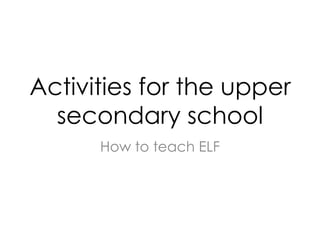
How to teach elf
- 1. Activities for the upper secondary school How to teach ELF
- 2. In practice • Raising learner awareness: In order to make informed choices about goals, learners will need to know about both ELF and EFL in the world today. • Activities designed to develop accommodation skills. 2
- 3. Teaching ELF Activity • Show students data about The English speaking populations of the world.(slide 5.) • Ask them to use the estimates in the first column in order to guess the populations of each of the different speaker groups. • Students should discuss their guesses in pairs or groups. • After seeing the answers, the whole class can discuss the chances of NNS-NNS interactions(ELF) taking place around the world, as opposed to NS-NNS interactions(EFL). 3
- 4. • Use a world map to highlight parts of the world where English is most likely to act as a lingua franca. • Introduce the idea of the Inner, Outer, and Expanding Circles. • Invite students to place their own country in one of the circles. • Discussion about the students experiences that they personally have had of using English both ELF and EFL. 4
- 5. Possible populations Speaker group Actual population Actual population Your guess Official 1200 million American English 400 million British English 230 million BBC English 200 million Indian English 57 million Native speakers 1 million Non-native speakers 5 Answers: AE: 230 mil, BE: 57 mil, BBC E: 1 mil, IE: 200 mil, NS: 400 mil, NNS: 1200 mil. (Crystal 2003)
- 6. Further activities • Productive task: Raising awareness about what the different acronyms mean: EFL, ELF, ENL and ESL. • Let the students work together and complete a chart such as the one in slide 7. • After giving the answers, clarify that the different roles that English plays depend on who is speaking to who, rather than where English is being used. • Discussion: Who decides what is correct and incorrect English in each of the four situations in the table? Who decides what is correct in ELF communication in the absence of native speakers? • There is no right or wrong. The aim is simply to increase learner awareness of how English works in different ways, e.g. lingua franca. 6
- 7. Acronym Full name Meaning EFL English as a (1)_______ language English when it is used by (5)_______ speakers to communicate with native speakers. ELF English as a (2)_______ language English when it is used by (6)_______ speakers who do not have the same first language. ENL English as a (3)_______ language English when it is used between two or more (7)______ speakers. ESL English as a (4)_______ language English when it is used in countries that were once colonized by the (8)_______. English when it is used by immigrants to countries where (9)______is the native language, (USA, UK, etc). Answers: 1. foreign; 2. lingua franca; 3. native; 4. second; 5. non-native speakers; 6. non-native; 7. native; 8. British; 9. English. 7
- 8. Activity about accents • Ask the students to name accents in their own country. • With a list of accents on the board, students can say which ones they prefer, and try to explain why. • Students can comment on how they feel about the standard accent in their own country, if there is one. • Let the students hear a number of recordings with people speaking with different accents. • As they listen, the students might want to guess the first-language background of each speaker. • Ask how the students feel when they hear their mother tongue being spoken by non-native speakers. • They can visit the Speech Accent Archive at the Internet, which provides audio clips of speakers from a wide variety of native and non-native backgrounds. The speakers all read the same text, which allows the students to compare different accents. 8
- 9. Students should begin to understand: • Accent variation is completely normal. • In some countries one accent has become the standard for various reasons, usually social, political, or economic. • Attitudes to different accents may be personal, and are more often based on feelings than on rational arguments. • Attitudes to different accents may also be based on social prejudices and stereotypes. 9
- 10. Didactic considerations • Re-thinking goals. • Modifying classroom practice. • Individual sounds are important. • Prepare students for significant variation. • Awareness of how English functions in the world today. • Bring out the idea of how accents variation is normal. • Accents and intelligibility are not the same. • Using both receptive and productive skills. • Modifying English according to the different grades. 10
